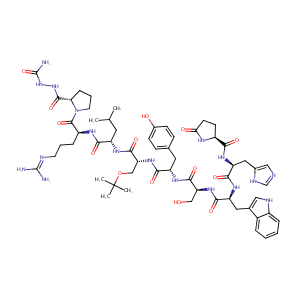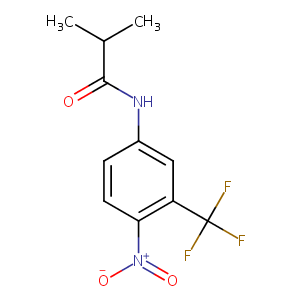| 1 |
ClinicalTrials.gov (NCT00769548) Radiation Therapy and Hormone Therapy in Treating Patients With Prostate Cancer
|
| 2 |
URL: http://www.guidetopharmacology.org Nucleic Acids Res. 2015 Oct 12. pii: gkv1037. The IUPHAR/BPS Guide to PHARMACOLOGY in 2016: towards curated quantitative interactions between 1300 protein targets and 6000 ligands. (Ligand id: 3879).
|
| 3 |
Goserelin FDA Label
|
| 4 |
URL: http://www.guidetopharmacology.org Nucleic Acids Res. 2015 Oct 12. pii: gkv1037. The IUPHAR/BPS Guide to PHARMACOLOGY in 2016: towards curated quantitative interactions between 1300 protein targets and 6000 ligands. (Ligand id: 6943).
|
| 5 |
Long-term effectiveness of adjuvant goserelin in premenopausal women with early breast cancer. J Natl Cancer Inst. 2009 Mar 4;101(5):341-9.
|
| 6 |
[Kuntai capsule combined with gonadotropin releasing hormone agonist in treatment of moderate-severe endometriosis: a clinical observation]. Zhongguo Zhong Xi Yi Jie He Za Zhi. 2014 Nov;34(11):1288-91.
|
| 7 |
A comparative study of the effect of raloxifene and gosereline on uterine leiomyoma volume changes and estrogen receptor, progesterone receptor, bcl-2 and p53 expression immunohistochemically in premenopausal women. Eur J Obstet Gynecol Reprod Biol. 2007 Nov;135(1):94-103. doi: 10.1016/j.ejogrb.2006.07.042. Epub 2006 Sep 14.
|
| 8 |
Prostate specific antigen expression does not necessarily correlate with prostate cancer cell growth. J Urol. 2006 Jul;176(1):354-60. doi: 10.1016/S0022-5347(06)00516-7.
|
| 9 |
Androgen receptor as a target in androgen-independent prostate cancer. Urology. 2002 Sep;60(3 Suppl 1):132-8; discussion 138-9.
|
| 10 |
The multidrug resistance-associated protein 1 transports methoxychlor and protects the seminiferous epithelium from injury. Toxicol Lett. 2003 Apr 30;142(1-2):61-70.
|
| 11 |
Identification of a novel glutathione conjugate of flutamide in incubations with human liver microsomes. Drug Metab Dispos. 2007 Jul;35(7):1081-8.
|
| 12 |
Metabolism of the antiandrogenic drug (Flutamide) by human CYP1A2. Drug Metab Dispos. 1997 Nov;25(11):1298-303.
|
| 13 |
Human CYP1B1 and anticancer agent metabolism: mechanism for tumor-specific drug inactivation? J Pharmacol Exp Ther. 2001 Feb;296(2):537-41.
|
| 14 |
Anti-androgenic effect of 6-formylindolo[3,2-b]carbazole (FICZ) in LNCaP cells is mediated by the aryl hydrocarbon-androgen receptors cross-talk. Steroids. 2020 Jan;153:108508. doi: 10.1016/j.steroids.2019.108508. Epub 2019 Oct 3.
|
| 15 |
Association of CYP1A1 and CYP1B1 inhibition in in vitro assays with drug-induced liver injury. J Toxicol Sci. 2021;46(4):167-176. doi: 10.2131/jts.46.167.
|
| 16 |
Nuclear receptor mediated induction of cytochrome P450 3A4 by anticancer drugs: a key role for the pregnane X receptor. Cancer Chemother Pharmacol. 2009 Jun;64(1):35-43.
|
| 17 |
Customised in vitro model to detect human metabolism-dependent idiosyncratic drug-induced liver injury. Arch Toxicol. 2018 Jan;92(1):383-399. doi: 10.1007/s00204-017-2036-4. Epub 2017 Jul 31.
|
| 18 |
Effects of various pesticides on human 5alpha-reductase activity in prostate and LNCaP cells. Toxicol In Vitro. 2007 Apr;21(3):502-8.
|
| 19 |
Identification of a group of brominated flame retardants as novel androgen receptor antagonists and potential neuronal and endocrine disrupters. Environ Int. 2015 Jan;74:60-70.
|
| 20 |
An in vitro coculture system of human peripheral blood mononuclear cells with hepatocellular carcinoma-derived cells for predicting drug-induced liver injury. Arch Toxicol. 2021 Jan;95(1):149-168. doi: 10.1007/s00204-020-02882-4. Epub 2020 Aug 20.
|
| 21 |
Effect of common medications on the expression of SARS-CoV-2 entry receptors in liver tissue. Arch Toxicol. 2020 Dec;94(12):4037-4041. doi: 10.1007/s00204-020-02869-1. Epub 2020 Aug 17.
|
| 22 |
PXR-mediated induction of P-glycoprotein by anticancer drugs in a human colon adenocarcinoma-derived cell line. Cancer Chemother Pharmacol. 2010 Sep;66(4):765-71. doi: 10.1007/s00280-009-1221-4. Epub 2009 Dec 30.
|
| 23 |
Prediction of drug-induced liver injury using keratinocytes. J Appl Toxicol. 2017 Jul;37(7):863-872. doi: 10.1002/jat.3435. Epub 2017 Jan 31.
|
| 24 |
Arylpiperazines for management of benign prostatic hyperplasia: design, synthesis, quantitative structure-activity relationships, and pharmacokinetic studies. J Med Chem. 2011 Jan 13;54(1):302-11. doi: 10.1021/jm101163m. Epub 2010 Dec 3.
|
| 25 |
Role of connexin 43 in cadmium-induced proliferation of human prostate epithelial cells. J Appl Toxicol. 2017 Aug;37(8):933-942. doi: 10.1002/jat.3441. Epub 2017 Feb 8.
|
| 26 |
DHT and testosterone, but not DHEA or E2, differentially modulate IGF-I, IGFBP-2, and IGFBP-3 in human prostatic stromal cells. Am J Physiol Endocrinol Metab. 2006 May;290(5):E952-60. doi: 10.1152/ajpendo.00451.2005. Epub 2005 Dec 20.
|
| 27 |
Evaluating the Role of Multidrug Resistance Protein 3 (MDR3) Inhibition in Predicting Drug-Induced Liver Injury Using 125 Pharmaceuticals. Chem Res Toxicol. 2017 May 15;30(5):1219-1229. doi: 10.1021/acs.chemrestox.7b00048. Epub 2017 May 4.
|
| 28 |
Proliferative and androgenic effects of indirubin derivatives in LNCaP human prostate cancer cells at sub-apoptotic concentrations. Chem Biol Interact. 2011 Feb 1;189(3):177-85. doi: 10.1016/j.cbi.2010.11.008. Epub 2010 Nov 25.
|
| 29 |
Curcumin downregulates homeobox gene NKX3.1 in prostate cancer cell LNCaP. Acta Pharmacol Sin. 2007 Mar;28(3):423-30. doi: 10.1111/j.1745-7254.2007.00501.x.
|
| 30 |
Development of a highly sensitive cytotoxicity assay system for CYP3A4-mediated metabolic activation. Drug Metab Dispos. 2011 Aug;39(8):1388-95. doi: 10.1124/dmd.110.037077. Epub 2011 May 3.
|
| 31 |
Species differences in tissue distribution and enzyme activities of arylacetamide deacetylase in human, rat, and mouse. Drug Metab Dispos. 2012 Apr;40(4):671-9. doi: 10.1124/dmd.111.043067. Epub 2011 Dec 29.
|
|
|
|
|
|
|


